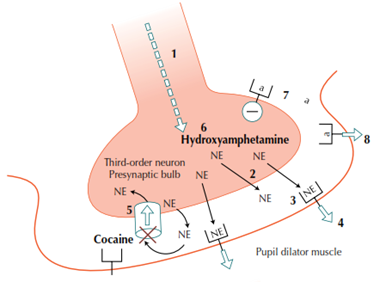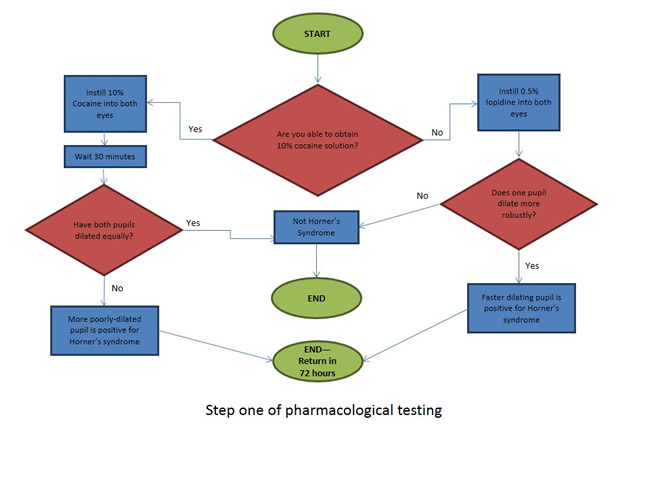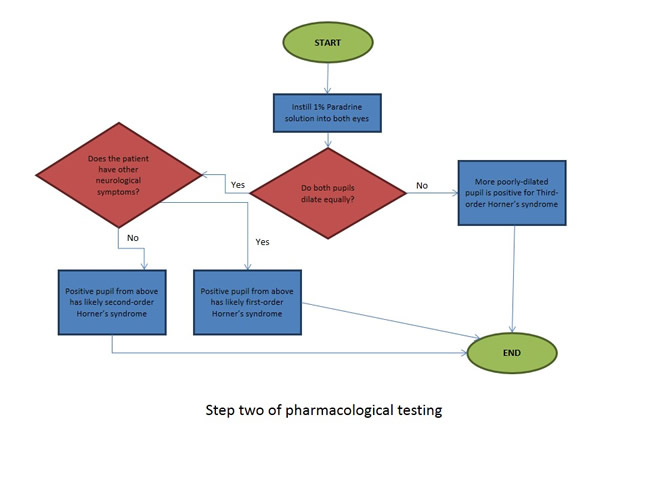- Welcome
- Topic 1: Background of Ocular Sympathetics
- Topic 2: Elements of the Case History
- Topic 3: Clinical Tests
- Topic 4: Confirmatory and Diagnostic Tests
- Topic 5: Patient Education
- Topic 6: Treatment and Referral
- Conclusion
- HELP
Topic 4: Confirmatory and Diagnostic Tests
Introduction and Objectives
After completing this unit, you will learn to:
- Identify with 100% accuracy, the characteristics of pharmacological agents that can be used to determine the type of Horner’s syndrome that is present; and
- Understand the appropriate use of these pharmacological agents in diagnostic tests, at the level of basic clinical fluency
Estimated time of completion: 7 minutes
Pharmacological Agents
Cocaine 10%
10% COCAINE DETERMINES WHETHER HORNER’S SYNDROME IS PRESENT OR NOT.
The following diagram represents a third-order sympathetic neuron ending on the iris dilator neuromuscular synaptic cleft. Norepinephrine (NE) is released as the neurotransmitter that propagates the signal from the neuron to the muscle, causing pupillary dilation.

Cocaine prevents the NE from being reuptaken from the synaptic cleft, causing a stronger dilation of the pupil.
In Horner’s syndrome, however, there is little NE in the synaptic cleft (since the sympathetic nervous supply to the dilator is interrupted), so the pupil will not dilate as much as in a normal pupil.
The steps for using 10% cocaine solution in the diagnosis of Horner’s syndrome are:
- Instill one drop of 10% cocaine solution in each eye
- Wait 30 minutes
- Determine the amount of pupillary dilation in each eye
- If normal: both pupils should dilate an equal amount
- If Horner’s: the affected pupil should dilate less than the unaffected pupil
Apraclonidine 0.5% (Iopidine)
IOPIDINE DETERMINES WHETHER HORNER’S SYNDROME IS PRESENT OR NOT.
- Used as a substitute to cocaine (which can be hard to obtain)
- Directly excites the sympathetic receptors on the iris dilator muscle, to cause pupillary dilation
- Its very dilute concentration causes only mild pupillary dilation, normally
- In Horner’s syndrome, the lack of NE in the synaptic cleft over long periods of time causes the muscle to react more robustly to stimulation
- Affected pupil will dilate more quickly than normal pupil
Hydroxyamphetamine 1% (Paradrine)
1% HYDROXYAMPHETAMINE DETERMINES WHETHER HORNER’S SYNDROME IS 3rd-ORDER OR NOT.
Hydroxyamphetamine causes the release of stored NE from the third-order neuron into the synaptic cleft, causing pupillary dilation.

If the third-order neuron is injured, it will not have NE stored in vesicles, however, and pupil dilation will not occur upon instillation of hydroxyamphetamine.
Hydroxyamphetamine is used to determine whether a previously-diagnosed Horner’s syndrome is caused by an injury to the third-order neuron.
The steps for using 1% hydroxyamphetamine in the diagnosis of Horner’s syndrome type are:
- Instill one drop of 1% hydroxyamphetamine solution in each eye
- Must be done 72 hours after cocaine use, to allow cocaine to wear off
- Wait 72 hours after apraclonidine use, too
- Determine the amount of pupillary dilation in each eye
- If normal: both pupils should dilate an equal amount in both eyes
- If 3rd-order Horner’s: the affected pupil should dilate less than the unaffected pupil
- If 2nd- or 1st-order Horner’s: both pupils should dilate an equal amount in both eyes
| Cocaine | Apraclonidine (Iopidine) | Hydroxyamphetamine (Paradrine) | |
|---|---|---|---|
| Concentration | 10% | 1% | 0.5% |
| Mechanism of Action | Blocks NE reuptake | Stimulate α-1 receptors | Releases stored NE into synaptic cleft |
| Normal response | Pupil dilation | Pupil dilation (mild) | Pupil dilation |
| Horner's syndrome response | Reduced pupil dilation | Pupil dilation (marked) | If 3rd-order: Reduced pupil dilation |
| If 1st- or 2nd-order: Normal pupil dilation | |||
| Tests for | Presence of Horner's syndrome | Presence of Horner's syndrome | Type of Horner's syndrome |
Flowcharts (click for larger image)
Page 13 of 25 | E-mail | Back to Top

